The Ultimate Pet Care Quiz
Let's see if your pet care knowledge is purr-fect or if you're barking up the wrong tree!

Bears have fascinated humans for millennia, appearing in our folklore, stories, and even constellations, stoking a sense of wonder about these often-misunderstood creatures.
Since our “What Type of Bear Are You?” quiz is a popular pastime for those looking to find their ursine soulmate here on BrainFall.com, we thought we’d explore the ursine world a bit more.
Not just the subject of children’s tales and nature documentaries, bears are a diverse group of large mammals that play a crucial role in their ecosystems. While your chances of encountering one might be slim—unless you live in bear country or have a penchant for wilderness adventures—learning about these majestic creatures can be both thrilling and enlightening.
Is there truth to the old saying: “If it’s black, fight back. If it’s brown, lie down. If it’s white, say goodnight.” ? Let’s find out as we dive into the world of bears!
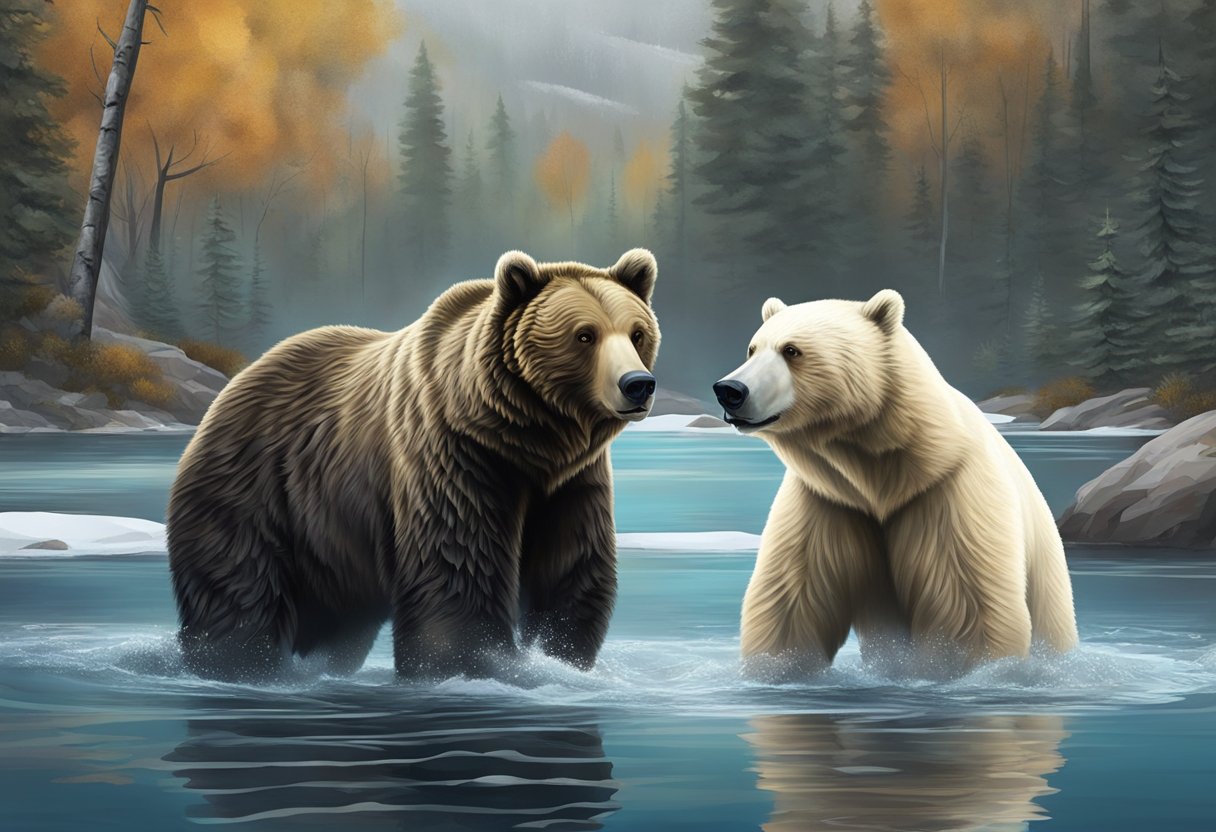
Covering various landscapes from the freezing arctic to dense tropical forests, bears have adapted in fascinating ways to survive. There are eight distinct species, each with its own unique set of traits, behaviors, and habitats. So, whether it’s the iconic grizzly bear with its fearsome reputation or the bamboo-munching giant panda stealing hearts with its playful antics, each bear species tells a story of evolution and survival. Despite their rough and tough image, these creatures are as complex as they are charismatic, with many facing threats that challenge their continued existence.
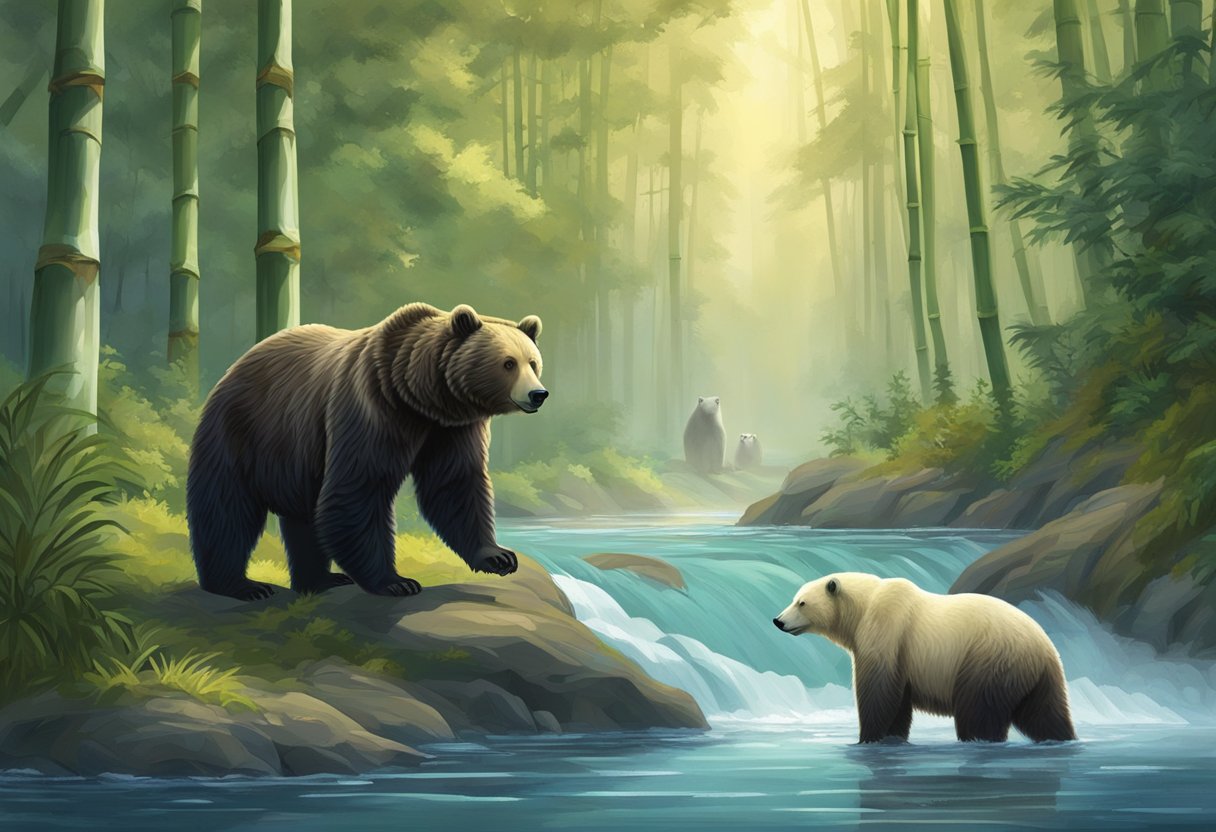
Within the bear family, or Ursidae, you’ll find a cozy set of species that might not all share the honey pot but definitely share a family tree. Let’s unpack their labels and relationships.
Bears are divided into eight species across three subfamilies, creating a jigsaw puzzle of fur and claws that spans the globe. Here’s a snapshot of the bear family picnic:
The term ‘subspecies’ might sound like a secondary gig, but these bears are main-show material in their own regions. Taking the spotlight here is the Brown Bear (Ursus arctos), which offers a variety of localized renditions, such as the Grizzly (Ursus arctos horribilis) in North America. It’s important to remember that while subspecies can have distinct features, they can still jam together and produce offspring. Think of them as different albums from the same artist — variation is the spice of life!
Throw on your lab coat and brush up your Latin, because it’s time to talk science names. Each bear gets a two-part Latin tag, which is like having a first and last name, but for the animal kingdom. The first part, the genus, is where you find several species grouped together like a last name for a family. For instance, the genus Ursus is where brothers and sisters like the American Black Bear (Ursus americanus) hang out. The species name, like arctos, is the bear’s unique identifier. Think of it as their personal hit single on the charts of science!

You’re about to embark on a whirlwind tour of where bears hang out around the globe. Keep your eyes peeled because we’re not just talking about one type of bear; there’s a whole lineup in these regions!
In North America, you’ve got a mixed bag of bruins roaming around. Your American black bears are widely distributed, claiming forested areas from Canada to Mexico. They’re the most common bears on the continent, so if you’re out and about in North America’s woods, chances are they’re your fuzzy neighbors. But don’t forget the grizzly bears, also known as brown bears, which you can spot in the northwest, especially in Alaska and parts of western Canada. They like their space, so they’re a bit choosier about where they settle down. And of course, the polar bears—iconic white wanderers of the Arctic—occupy the northernmost edges, particularly along the coast and ice flows where they can hunt for seals.
Asia is where things get really interesting. The continent is home to the Asiatic black bear, the shaggy sun bear, and don’t get me started on the beloved giant panda—they’ve made a name for themselves with their unique bamboo diet and black-and-white fur. Each resides in distinct habitats across this vast continent, with the Asiatic black bear favoring forested mountain ranges and the sun bear sticking to the tropical forests. Pandas, meanwhile, are the cool kids of the central Chinese mountain ranges, munching on bamboo like it’s going out of style.
Europe is running a bit light on bears, but it still boasts populations worth noting. The brown bear, or what North Americans call a grizzly bear, is the main act here. They’re found in pockets across the continent, primarily in woodlands that span from the Iberian Peninsula all the way to Russia, proving that whether they’re called grizzlies or brown bears, these guys have quite the fanbase across a range of zip codes.
Last stop, South America—say hola to the spectacled bear! These guys sport markings that look like they’re wearing glasses, hence the name. They’re the exclusive bear residents of this continent, preferring the Andean mountain life. It’s a more reclusive life away from the hustle and bustle, living in cloud forests and paramo ecosystems. If you ever find yourself hiking up high in the Andes, keep a lookout for these bespectacled beauties.
So, that’s your bear itinerary! Now you know where to look (or not look) when wandering around these regions. Keep your eyes peeled and respect the locals—after all, it’s their home turf you’re exploring!

When you look at bears, their presence is as impressive as their fur is fluffy. They’ve got a range of sizes that could make any weightlifter green with envy, and their fur? Well, let’s just say they pull off natural ombré better than any salon could. Here’s the lowdown on their fittings and features.
Black Bears: Your typical American black bear is like the compact car of the bear world: nifty and more moderate in size. On all fours, they measure up to 3 feet tall at the shoulder and can weigh up to 660 pounds. They’re stretchy, too – when they stand up, think 5.5 feet of bear!
Grizzly Bears: Now these are the muscle trucks. Grizzlys can tower up to 8 feet and range from 400 to 790 pounds, with the Kodiak bear variant maxing out the scales.
Polar Bears: The ice giants among bears, polar bears can weigh a jaw-dropping 990 to 1,600 pounds. They can reach a height of about 5 to 8 feet when standing.
Giant Pandas: Cuddly but hefty, giant pandas tip the scales at 200 to 300 pounds and stretch up to 5 feet.
If you’ve ever envied a bear’s coat in a nature documentary, you’re not alone. The fur game is strong with these ones.
Black Bears: True to their name, these bears usually sport sleek black fur, but they’ve been known to rock brown or even cinnamon shades. Versatile!
Brown Bears: They range from dark brown through to light tips, creating the “grizzled” look we associate with them – hence, grizzly!
Polar Bears: They’ve got the polar look down with their white fur, perfect for blending into their snowy surrounds.
Giant Pandas: Pandas break the mold with their unique black and white fur. They’re basically the yin and yang of the bear world.
Spectacled Bears and Sun Bears: These less talked about, but equally fabulous bears, sport different shades of brown and unique markings, like the spectacle-like rings around the eyes of spectacled bears.
Bears are more than just pretty faces. Every species has its little quirks.
Black Bears: Their ears are more prominent and pointy than their friends’. Very elf-like, if you will.
Grizzly Bears: Their powerful hump muscles on their backs are their most distinctive feature – it’s all about shoulder strength.
Polar Bears: They’ve got huge paws to distribute their weight when treading on ice, sort of like natural snow shoes. Handy, eh?
Giant Pandas: It’s all about that face. Those iconic patches aren’t just cute, they are like built-in shades that help reduce glare.
So there you have it, your bear basics. Just remember, you’re unlikely to fit into any of their size categories – and that’s probably for the best. Keep admiring their fantastic fur patterns and unique features from a safe distance or the comfort of your couch.
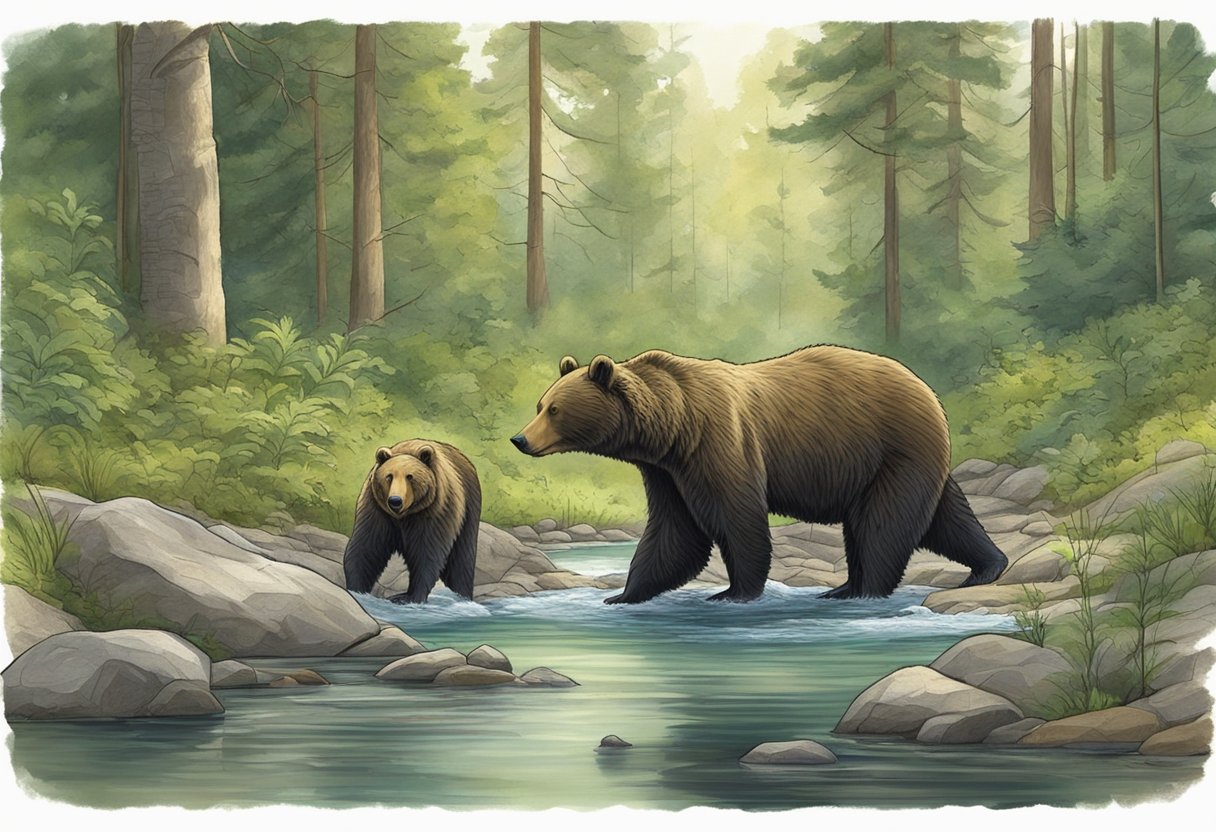
Bear behavior and ecology are as fascinating as they are varied. You’re about to discover how these furry giants meet the daily demands of their wild lives, from their diverse diets to their unique reproductive strategies, not to mention how they deal with the changing seasons.
Bears have quite the menu to choose from in the wild, with their diets ranging from omnivorous to strictly herbivorous or carnivorous. Let’s break it down:
When available, many bears won’t hesitate to snag some fish, especially salmon – they seem to love a good sushi plate.
When it comes to dating, bears have their own calendar with mating season typically kicking off in late spring to early summer. Here’s the bare-bones scoop on bear romance:
Bears are the ultimate planners of seasonal living:
Remember, these furry friends live by the seasons, so keep your picnic baskets secure and respect their wild habits.
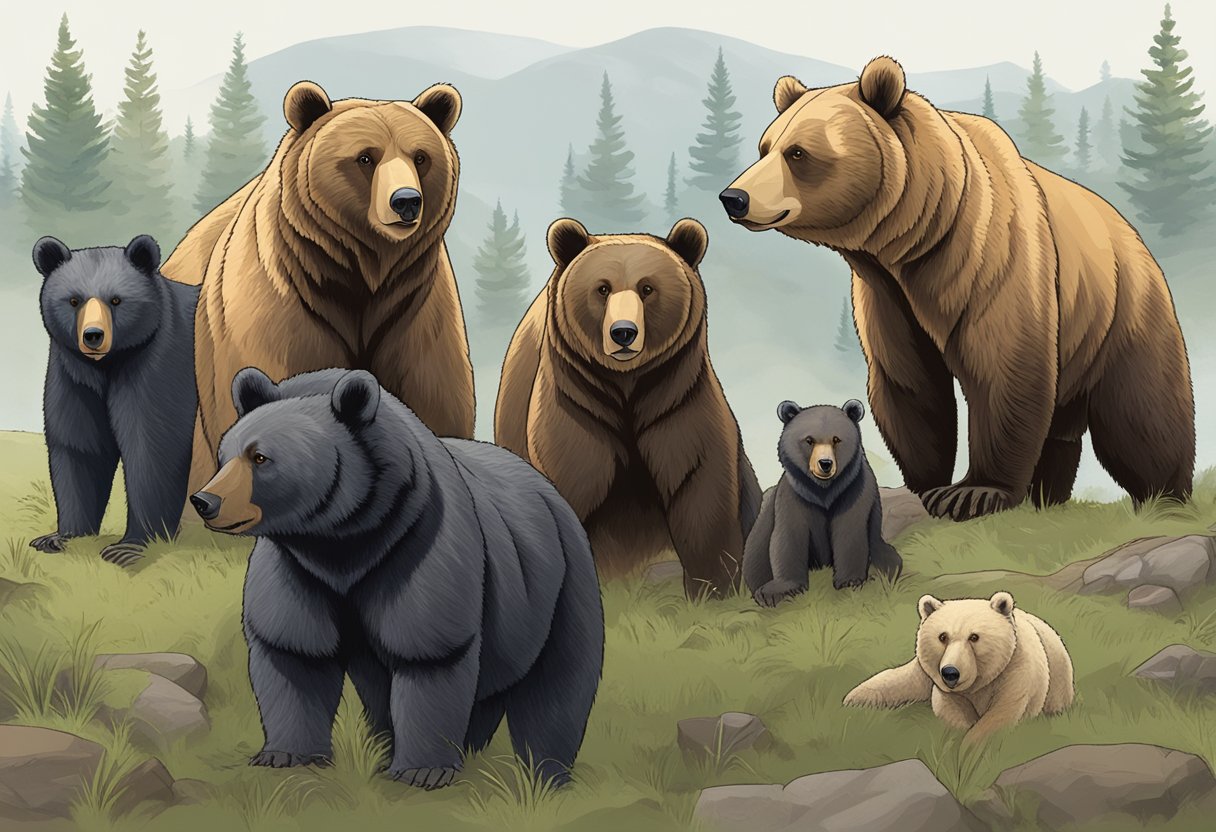
In the world of bears, your favorite fluffy giants are facing some rough times. The biggest buzzwords in their world are “vulnerable,” “endangered,” and “habitat loss,” but don’t let that dampen your spirit—with a bit of “conservation” magic, there’s hope on the horizon.
Let’s talk about which of your bear buddies are sending out SOS signals. First on the list, we’ve got the polar bears—these icy giants are listed as “threatened” in the US since 2008 thanks to climate change RSVP’ing uninvited to their ice party. Then you have your spectacled bears, sun bears, sloth bears, and giant pandas. They’re all part of the “vulnerable to extinction” VIP club as per the International Union for Conservation of Nature (IUCN). And let’s not forget the grizzly bears in the contiguous United States, they’re holding tight at “less than 1,500,” which rightly earns them a “threatened” status under the Endangered Species Act.
Now for the part where we roll up our sleeves and get our hands dirty—habitat conservation. Imagine trying to throw a party when your house is slowly disappearing. That’s the deal with habitat loss, and it’s a real party pooper for bears worldwide. The habitats we’re trying to keep in check include everything from forests and tundras (where the brown bears roam and sometimes pretend to be humans with their impressive bipedal stances) to tropical rainforests and arctic ice. Big paw high-fives go to the conservation efforts taking place in over 65 countries. These are the critical moves making sure the bears’ postal codes don’t go extinct.
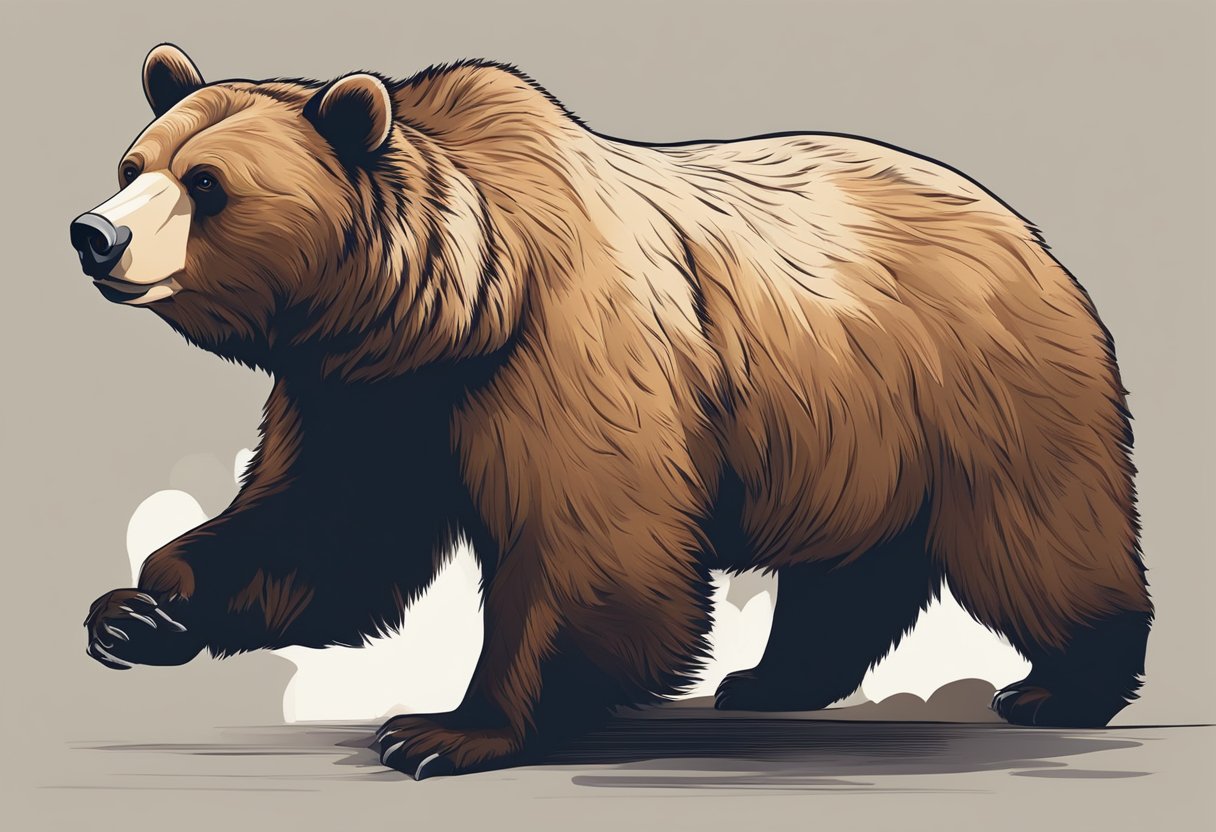
Before you dive nose-first into the wild world of bear encounters, it’s key to grasp how these furry giants impact our culture and safety.
Bears have a big, burly presence in various forms of arts and culture, often symbolizing strength and wilderness. You’ve seen them in countless stories, legends, and even as mascots or statues that seem to roar, “Hey, I’m here, respect nature!” From cave paintings to contemporary films, they’re cultural icons with an undeniable allure.
Bear-Inspired Art and Culture:
Let’s get to the real meat of the matter—bumping into a bear in the great outdoors. Safety first, right? The thrill of seeing one is real, but so is the danger. Bear encounters can happen, especially if you’re strutting around in their habitat. Your actions can either make you a legend at the campfire or a headline in the news.
If you happen across a bear, stay calm. Remember that attacks are rare, and bears usually prefer to avoid confrontations—though they definitely won’t say no to a surprise picnic basket.
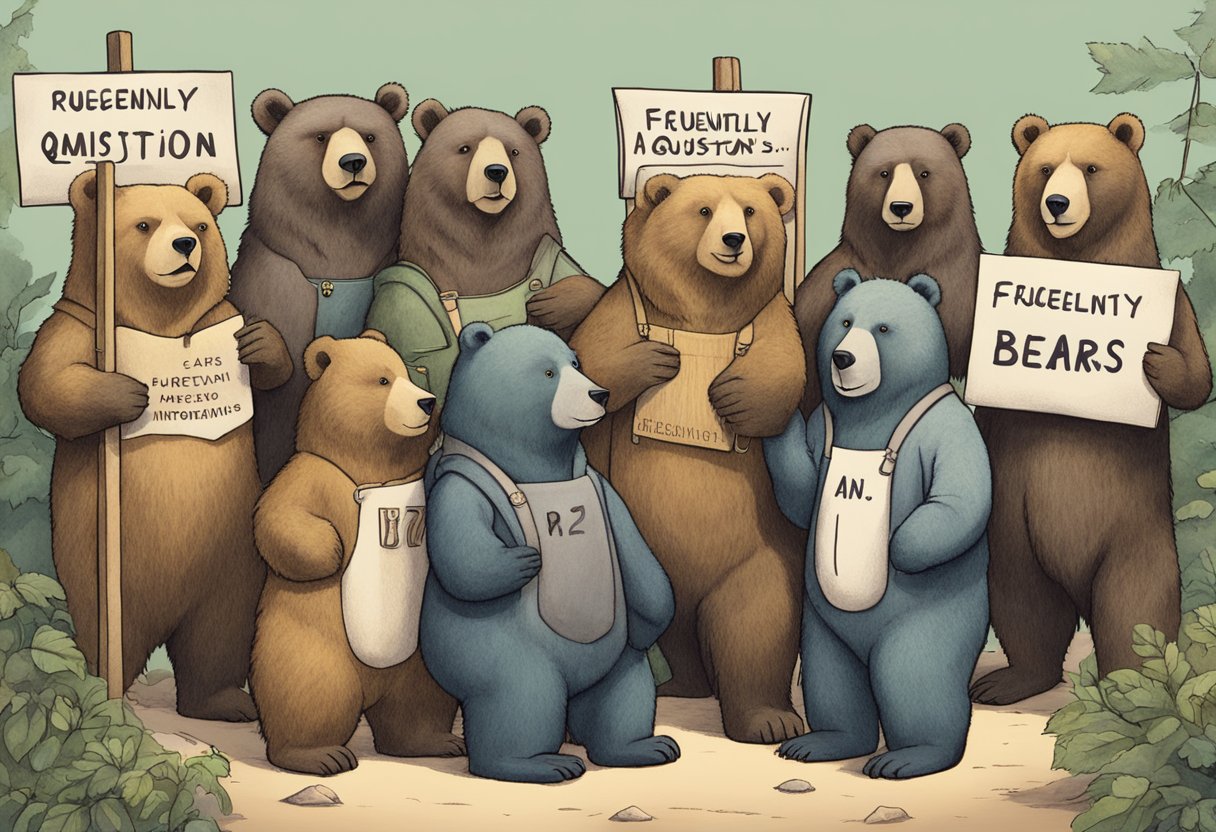
Let’s dig into the bear essentials with some of the most curious questions about our burly friends from around the globe.
You might be surprised to learn that there are eight distinct species of bears roaming our planet. Among them are the Brown Bear, Asiatic Black Bear, American Black Bear, Polar Bear, Giant Panda, Sloth Bear, Sun Bear, and Spectacled Bear, each with its own habitat and lifestyle.
If you’re wondering about the bear to watch out for on your wilderness adventure, the Polar Bear typically holds the title for being the most aggressive towards humans. But remember, it’s not aggression but survival instinct that drives their behavior – we’re not on their menu.
Population sizes can swing faster than a bear’s mood from species to species: The American Black Bear enjoys a large, thriving population while the Giant Panda’s numbers are quite limited, making them a conservation priority.
Now, to spot the difference between these furry giants, you should look at their size, color, habitat, and diet. For instance, the Polar Bear is the largest and loves cold climates, while the Sun Bear is smaller and sticks to tropical forests.
Ready for a bear rarity? The Giant Panda takes this crown, not just because of its unique diet of bamboo but because it’s the most restricted in terms of range and numbers. However, extensive conservation efforts have been helping improve their status.
On the American turf, your local bruins are the American Black Bear, famous for their versatility, and the larger, more recluse Brown Bear, also known as the Grizzly when inland. Be bear aware if you stumble upon these guys in the wild!